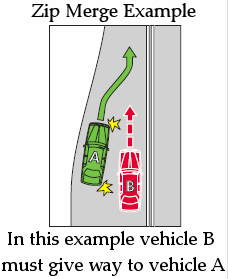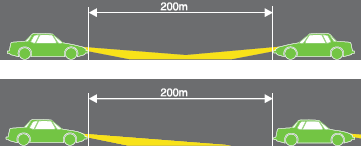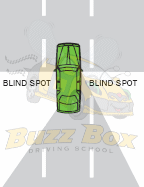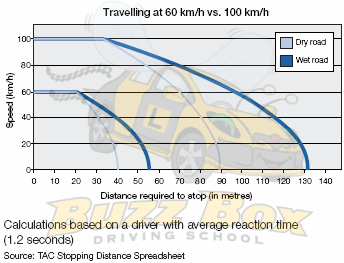|
Driving TipsEssential Road RulesThere is very common road rules that you will need to
know while driving in the Latrobe Valley and Victoria.
Quite often some of these rules learners aren't sure of
and fail a driving test. Our Essential Road Rules page
is a must see before you go on a driving lesson, go for
your L's or P's. Common Road Rules videos by VICROADSVicroads have released a bunch of road rules videos and
have put them on YOUTUBE. These videos are very helpful in
learning the basic rules. We would highly recommend that
you watch these videos. Please see the Vicroads Road Rules Videos page for the
videos. Blind Spots
When passing a truck, be sure to look in the driver's rear side-view mirror. Chances are he is watching you. If you cannot see the truck driver, he cannot see you! Move ahead and complete the pass safely, keeping an eye on the truck driver's mirror. And remember that the heavier the vehicle, the longer it takes them to stop, so don't just pass the truck then cut into its safety gap. Indicate left and wait until you see both headlights in the rearview mirror before turning. Turn into the lane and continue at the same cruising speed whenever safe to do so. ScanningScanning is the skill of keeping your eyes moving. Progressively work your eyes from far away to objects nearby. A good pattern is to look in the distance, at the road surface, to the sides of the road, your mirrors, then your instruments. This pattern should be repeated continuously every 5 to 10 seconds. As part of your scanning to the sides look through fences and under parked vehicles for signs of pedestrians or animals. Clear WindowsIt's very important before you start driving that your windows are clear and that you don't have things in the car obstructing your view. Always defrost your windows completely before driving. Your car's Air Conditioner can assist in this task both summer and winter. Rule 297 Road Rules Victoria. MirrorsWhen driving you must check your mirrors regularly. Failure to do so can lead to accidents and also failing your Driving Test. You must check your mirrors before Braking, Turning or Diverging. SteeringWe recommend the push-pull steering method. Please see our Steering page for further information. Oil PatchesVehicles with leaky engines drop oil onto the road and it tends to accumulate at stop signs and stop lines where cars are often stationary. Over time, the oil creates a very slippery surface, unfortunately heavy or late breaking is often needed at precisely the same spots where the oil has accumulated and it can cause accidents. Be aware of the dangers and try to avoid braking heavily in these areas. HeadcheckA headcheck means looking over your shoulder to see things through the rear side windows - but don't take your eyes off the road ahead for more than a second. Stopping DistancesAt 60 km/h you may cover up to 67 meters before you can stop. At 100 km/h you may cover up to 142 meters before you can stop. The TAC wipe off 5 campaign talks about stopping distances as speed increases. Stopping Distances in Poor Weather Conditions & High-Speed Conditions
Driving ExperienceThe more hours spent practicing driving in different conditions with your driving instructor and supervising driver the better chance of you not having an accident when driving solo once you get your P's. Research shows that learner drivers with 120 hours of driving practice can reduce their risk of a crash during their first two years of solo driving by 30% Source: VICROADS. Merging
There are two kinds of merges in Victoria. In one of these situations two lanes will join together without a dotted line between the two lanes. This kind of Merge is a Zip Merge. You must give way to any vehicle which has any part of its vehicle ahead of yours. The second type of merge is where vehicles must cross a dashed line. In this situation the vehicle crossing the line must give way to any vehicle already travelling in the lane the driver wishes to enter. This type of merge commonly occurs on freeway entry ramps. Headlights
Your headlights must be on between dusk to dawn. They must also be on in hazardous weather conditions where there is reduced visibility. You must dip your headlights within 200 meters of an oncoming vehicle. You must also dip your headlights when following within 200 meters of another vehicle. Keeping a safe distance behind other vehiclesRoad Rule 126 States: A driver must drive a sufficient distance behind a vehicle travelling in front of the driver so the driver can, if necessary, stop safely to avoid a collision with the vehicle. A safe distance in ideal driving conditions is considered to be a 2 second gap. A 2 second gap at 100 km/h will be 54 meters gap between the car in front and the one travelling behind. This is about the same distance as 2.5 cricket pitches. Mobile Phone Distractions
Road Laws & Further InformationAll of the current road laws are freely available from the VICROADS website. |



 Believe
it or not, every car has a blind spot. A blind spot is an
area that you are unable to see in your rearview and side
mirrors. Sometimes a car might cruise right into that
spot, sit for a bit, and you might forget he's there.
Maybe your cruise control is on and his cruise control is
on as well, so you are both advancing at the same speed.
Not only should you indicate your intention to move into
the next lane for at least 3 seconds but, if you don't
physically turn your head and do a quick one-second peak
through your rear side windows before you change lanes,
you might turn into the path of the car beside you and
cause a collision. You should be constantly checking your
mirrors so you are always aware of vehicles sharing the
road with you.
Believe
it or not, every car has a blind spot. A blind spot is an
area that you are unable to see in your rearview and side
mirrors. Sometimes a car might cruise right into that
spot, sit for a bit, and you might forget he's there.
Maybe your cruise control is on and his cruise control is
on as well, so you are both advancing at the same speed.
Not only should you indicate your intention to move into
the next lane for at least 3 seconds but, if you don't
physically turn your head and do a quick one-second peak
through your rear side windows before you change lanes,
you might turn into the path of the car beside you and
cause a collision. You should be constantly checking your
mirrors so you are always aware of vehicles sharing the
road with you. 